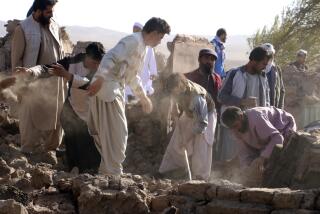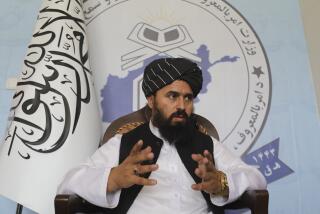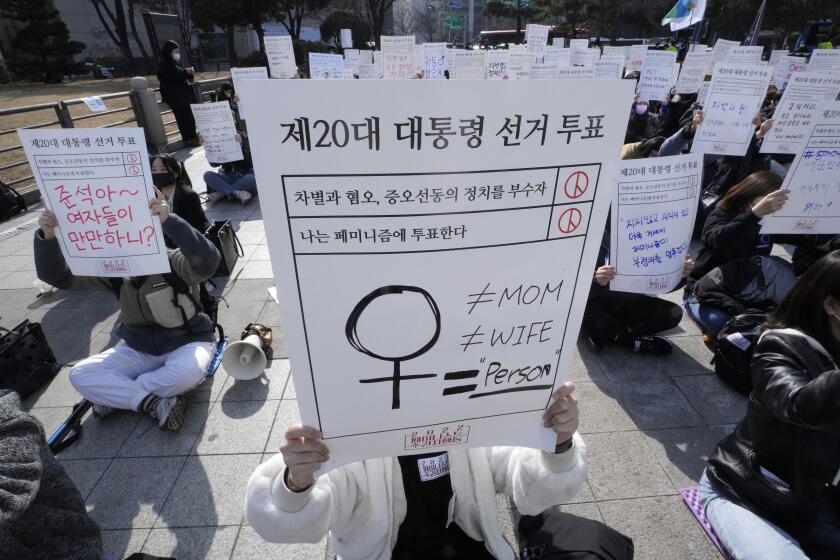A 100-Acre Summary of Afghan Needs
- Share via
KABUL, Afghanistan — The Afghan government is working as fast as it can to put together a wish list for donor nations gathering this week in Tokyo. It might be simpler if the government could bring the donors to the Jangalak industrial complex on the outskirts of Kabul and let them see what this nation needs: almost everything.
Jangalak might be viewed as Afghanistan shrunk to 100 acres, available for viewing--and lamenting--in a day. Before it was turned to moonscape by the wars of the early 1990s, Jangalak was a factory like few others in the world, providing materials for virtually every industrial need in the nation.
Having grown out of a small brick factory and metal works, and further enlarged by the Soviets during the 1980s, Jangalak manufactured everything from ball bearings to generators. Its 3,000 workers built electric transformers, shaped parts for helicopters, and bottled ether for hospitals. Jangalak was the nation’s main brick factory, its main tool shop, its only manufacturer of car bodies, its only semimodern lumber mill.
Today, only 150 workers still have jobs, most as guards who keep a lookout for squatters. The other workers perform a single manufacturing task: melting the few remaining, ruined engine blocks down into small balls of steel to be sold as measuring weights.
The cost of reconstructing Jangalak to a point where it could turn out at least a few more sophisticated products, according to the Ministry of Planning, is about $50 million.
Then there is the rest of the country--more than 4,500 miles of paved roads that need to be repaired or rebuilt, at costs ranging from $40,000 a mile to $155,000 a mile; 210,000 civil servants and 25,000 police officers who haven’t been paid in six months and need about $35 million just to catch up; a heater for the battered presidential palace, where the temperature inside was about 45 degrees when Secretary of State Colin L. Powell met with interim Prime Minister Hamid Karzai on Thursday.
Estimates vary, but several government officials and international aid agencies say 75% to 85% of Afghanistan’s infrastructure has been damaged to the point of uselessness or destroyed during more than two decades of war.
“When we are born, we are fed by the breast of our mother, and so we know who our mother is,” said Abdul Qudus, 55, a guard at Jangalak whose face seems permanently set in a sad smile. For 25 years, he worked the looms in one of the weaving buildings here, before they were destroyed and looted along with the rest of the complex by moujahedeen warlords. “The bastards who did this didn’t recognize their own mother.
“This,” he said, opening his arms to the destruction, “was their mother.”
Disagreements have risen already as to how much money is needed--and over how long a period--to rebuild Afghanistan. Planning Minister Haji Mohammed Mukhaqiq raised eyebrows when he placed the 10-year total at $45 billion. Many in the interim government here, as well as at the World Bank and United Nations, say the amount should be closer to $10 billion or $15 billion, of which $100 million is needed urgently.
Ten years and $15 billion, however, would be just the beginning, everyone agrees, even if peace prevails--by no means a certainty at this point. With an ongoing war and a brand-new government, Afghanistan is certain to face hard questions at the gathering Monday and Tuesday in Tokyo about whether it can handle massive donations properly, keeping the money from being siphoned by warlords or eventually going to fund more factional fighting.
As it prepares to defend itself, Karzai’s nascent administration also is trying to determine what needs rebuilding, what needs replacing, what needs improving. Very few things, down to the mine-littered earth itself, don’t fit into one of those categories.
It’s difficult to know, however, where to begin.
No Phones, No Surprise
There isn’t a single phone in all of Jangalak. This would come as no surprise to any Afghan. Kabul, the capital, is the only place in the country with working telephones. There are an estimated 100 to 150 of them--in a city of 1.2 million to 1.8 million people. The telephones function perhaps 5% or 10% of the time, and can ring only one another, not, say, a phone across the border in Pakistan.
Jangalak once had more than 100 buildings, some with massive lighted signs reading “Boiler Room” or “Tool and Die.” There was a movie theater, a guest house, even a saloon back when alcohol was allowed in this Islamic state. Of all the light fixtures in the sprawling complex, two remain unbroken. Even if their electrical connections weren’t severed, the bulbs would probably light for only about 2 1/2 hours a day, the average dose of power here.
Money for communications and power improvements will be among Afghanistan’s top requests in Tokyo. Another will be for money to build or rebuild homes so that 5 million refugees can return. The first efforts are planned for neighborhoods near Jangalak, on the west side of Kabul, and on the Shomali plain, north of the city.
In the western and southern parts of Kabul, about 40,000 homes were destroyed during the fighting in the 1990s between moujahedeen commanders, Reconstruction Minister Mohammed Amin Farhang said. On the Shomali plain, Taliban forces had taken charge of the demolition, leveling an estimated 50,000 mostly mud-brick homes in a scorched-earth effort to deny any advantage to their Northern Alliance rivals.
“We must have houses,” Farhang said, “or our people won’t come home.”
Farhang, an economist in Germany for the last 20 years, is one of many ministers to return from abroad to help rebuild his homeland. He lives in Kabul’s Intercontinental Hotel, by far the most luxurious in Afghanistan. He uses a bucket of water to flush his toilet, has bullet holes in his windows and in the morning steps into a lobby where the temperature has often dropped below freezing.
Farhang knows his situation is infinitely better than that of the people he is trying to help. Among them is 40-year-old Omara Khan, who returned one recent day to his home on the Shomali plain, a village called Bagareq-e-Chinar, with his wife and eight children.
“I am so happy to be back in my village, I am going to lie in the dirt,” Khan declared with glee before stretching out on a flat swath of earth. When asked which of the roofless, burned-out homes nearby was his, Khan looked up from where he lay: “This is my home. It’s not here now, but I am lying where my bed was.”
Like 85% of Afghans, Khan was a subsistence farmer, growing potatoes and onions. The Taliban, however, had mined much of the fields around Bagareq-e-Chinar, destroyed irrigation canals, and poisoned the wells, most of which produce little, if any, water after three years of drought. As a result, assistance with agricultural projects is also high on the government’s priorities list.
The village and Jangalak are like many parts of the country in that they were not only devastated during battles but also plundered when the firing stopped.
Last of the Giant Cranes
Jangalak had 150 giant crane systems. One is left. Pakistan-funded warlord Gulbuddin Hekmatyar and his men took the rest, everyone around says, selling them in Pakistan to buy more weapons. They took the steel structural supports, piping and water tanks, and stripped the copper wire out of virtually every electrical item. They took the tools, the dies, the new bricks and lumber, the shelving and faucets and forklifts. They took almost everything and destroyed what they couldn’t remove.
About the only items Hekmatyar’s men neither stole nor damaged were 70 giant water and fuel tanks, the guards at Jangalak say. When the Taliban forces seized power in 1996, they sold the tanks in Pakistan.
“You name it, they need it,” said Ahmed Fawzi, spokesman for the U.N. special envoy to Afghanistan, Lakhdar Brahimi.
The neighborhood around the Jangalak factory, also known as Jangalak, once had two elementary schools. Both are gone. With so many teachers having left the country, and with women not allowed to teach under the Taliban and girls not allowed in schools, the student-teacher ratio nationwide is now about 200 to 1, according to the United Nations.
In Bamian province west of here, there is a health clinic for men but none for women. In the western city of Herat, almost all the power lines that once delivered electricity have been snapped. In some remote villages of Balkh province in the north, people are eating bread made largely of dry grass.
At Jangalak, a 14-year-old boy named Gulbuddin grazes his family’s 20 goats among the bomb craters and detritus. He began bringing them here, he said, after a cow and seven goats were blown up by mines in the hills nearby.
Abdul Qudus, the guard, hasn’t been paid in several months, he said, but he comes to work in the hope that he’ll be paid soon. He also comes because he loves this place.
“With my whole heart,” he said, patting his chest. “Afghans don’t like to ask for things from other people. Today, we have to ask for help.”
More to Read
Sign up for Essential California
The most important California stories and recommendations in your inbox every morning.
You may occasionally receive promotional content from the Los Angeles Times.













